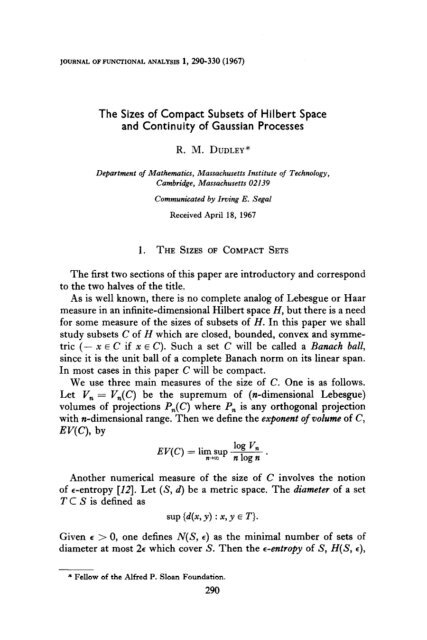On the Characters and the Plancherel Formula of Nilpotent Groups ...
On the Characters and the Plancherel Formula of Nilpotent Groups ...
On the Characters and the Plancherel Formula of Nilpotent Groups ...
Create successful ePaper yourself
Turn your PDF publications into a flip-book with our unique Google optimized e-Paper software.
JOURNAL OFFUNCTIONAL ANALYSIS 1, 290-330 (1967)<br />
The Sizes <strong>of</strong> Compact Subsets <strong>of</strong> Hilbert Space<br />
<strong>and</strong> Continuity <strong>of</strong> Gaussian Processes<br />
R. M. DUDLEY*<br />
Department <strong>of</strong> Ma<strong>the</strong>matics, Massachusetts Institute <strong>of</strong> Technology,<br />
Cambridge, Massachusetts 02139<br />
Communicated by Irving E. Segal<br />
Received April 18, 1967<br />
1. THE SIZES OF COMPACT SETS<br />
The first two sections <strong>of</strong> this paper are introductory <strong>and</strong> correspond<br />
to <strong>the</strong> two halves <strong>of</strong> <strong>the</strong> title.<br />
As is well known, <strong>the</strong>re is no complete analog <strong>of</strong> Lebesgue or Haar<br />
measure in an infinite-dimensional Hilbert space H, but <strong>the</strong>re is a need<br />
for some measure <strong>of</strong> <strong>the</strong> sizes <strong>of</strong> subsets <strong>of</strong> H. In this paper we shall<br />
study subsets C <strong>of</strong> H which are closed, bounded, convex <strong>and</strong> symme-<br />
tric (- x E C if x E C). Such a set C will be called a Banach ball,<br />
since it is <strong>the</strong> unit ball <strong>of</strong> a complete Banach norm on its linear span.<br />
In most cases in this paper C will be compact.<br />
We use three main measures <strong>of</strong> <strong>the</strong> size <strong>of</strong> C. <strong>On</strong>e is as follows.<br />
Let V, = V,(C) be <strong>the</strong> supremum <strong>of</strong> (n-dimensional Lebesgue)<br />
volumes <strong>of</strong> projections P,(C) where P, is any orthogonal projection<br />
with n-dimensional range. Then we define <strong>the</strong> exponent <strong>of</strong> volume <strong>of</strong> C,<br />
J-V), by<br />
1% vn<br />
EV(C) = lim sup ~.<br />
n+cc nlogn<br />
Ano<strong>the</strong>r numerical measure <strong>of</strong> <strong>the</strong> size <strong>of</strong> C involves <strong>the</strong> notion<br />
<strong>of</strong> E-entropy [12]. Let (S, d) b e a metric space. The diameter <strong>of</strong> a set<br />
T C S is defined as<br />
sup (4% r) : x, y E T).<br />
Given E > 0, one defines N(S, E) as <strong>the</strong> minimal number <strong>of</strong> sets <strong>of</strong><br />
diameter at most 2~ which cover S. Then <strong>the</strong> r-entropy <strong>of</strong> S, H(S, E),<br />
* Fellow <strong>of</strong> <strong>the</strong> Alfred P. Sloan Foundation.<br />
290

















